Tupolev Tu-160
The Tupolev Tu-160 (Russian: Туполев Ту-160 Белый лебедь, romanized: Belyj Lebeď, lit. 'White Swan';[1] NATO reporting name: Blackjack) is a supersonic, variable-sweep wing heavy strategic bomber designed by the Tupolev Design Bureau in the Soviet Union in the 1970s. It is the largest and heaviest Mach 2+ supersonic military aircraft ever built and next to the experimental XB-70 Valkyrie in overall length.[2] As of 2021, it is the largest and heaviest combat aircraft, the fastest bomber in use and the largest and heaviest variable-sweep wing airplane ever flown.[3]
| Tu-160 Belyy Lebed | |
|---|---|
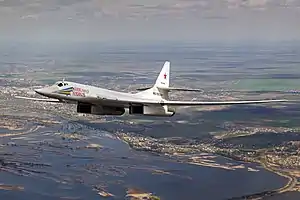 | |
| Tupolev Tu-160 Aleksandr Novikov in flight over Russia, May 2014 | |
| Role | Supersonic strategic heavy bomber |
| National origin | Soviet Union |
| Design group | Tupolev |
| Built by | Kazan Aircraft Production Association |
| First flight | 18 December 1981 |
| Introduction | April 1987 |
| Status | In service |
| Primary users | Russian Aerospace Forces Soviet Air Forces (historical) Ukrainian Air Force (historical) |
| Produced | 1984–1992, 2002, 2008, 2017 |
| Number built | 36 (9 test and 27 serial) |
Entering service in 1987, the Tu-160 was the last strategic bomber designed for the Soviet Union. As of 2016, the Russian Air Force's Long Range Aviation branch has at least 16 aircraft in service.[4] The Tu-160 active fleet has been undergoing upgrades to electronics systems since the early 2000s. The Tu-160M modernization programme has begun with the first updated aircraft delivered in December 2014.
Development
Origins
The first competition for a supersonic strategic heavy bomber was launched in the Soviet Union in 1967. In 1972, the Soviet Union launched a new multi-mission bomber competition to create a new supersonic, variable-geometry ("swing-wing") heavy bomber with a maximum speed of Mach 2.3, in response to the US Air Force B-1 bomber project. The Tupolev design, named Aircraft 160M, with a lengthened blended wing layout and incorporating some elements of the Tu-144, competed against the Myasishchev M-18 and the Sukhoi T-4 designs.[5]
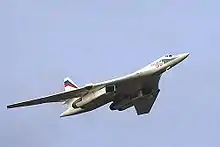
Work on the new Soviet bomber continued despite an end to the B-1A and in the same year, the design was accepted by the government committee. The prototype was photographed by an airline passenger at a Zhukovsky Airfield in November 1981, about a month before the aircraft's first flight on 18 December 1981. Production was authorized in 1984, beginning at the Kazan Aircraft Production Association (KAPO).[6]
Modernization
First overhauled and partially modernised aircraft was accepted into Russian service after testing in July 2006. The aircraft reportedly received a capability to use conventional weapons, but was not upgraded with new avionics as previously planned.[7][8] First modernised aircraft capable to carry the new long-range Kh-555 nuclear cruise missile was delivered to the Russian Air Force in April 2008;.[9][10] a follow-up contract for modernisation of three more aircraft is estimated to cost RUR3.4 billion (US$103 million).[11]
The modernisation appeared to be split into two phases, first concentrating on life extension with some initial communication–navigation updates, followed by engine upgrades after 2016.[12] In November 2014, a Tu-160 upgraded with new radar and avionics performed its first flight.[9] The aircraft was delivered to the Russian Air Force as Tu-160M model in December 2014.[13][14] The phase I update was due to be completed by 2016, but industrial limitations may delay it to 2019 or beyond.[15] Although Kuznetsov designed an NK-32M engine with improved reliability over the NK-32 engines, its successor company has struggled to deliver working units. Metallist-Samara JSC had not produced new engines for a decade when it was given a contract in 2011 to overhaul 26 of the existing engines, by two years later, only four were finished.[15] Ownership and financial concerns hinder the prospects of a new production line; the firm insists it needs a minimum of 20 engines ordered per year but the government is only prepared to pay for 4–6 engines per year.[15][16] A further improved engine has been bench tested and may enter production in 2016 or later.[12]
On 29 April 2015, Russian Defense Minister Sergei Shoigu announced Russia was resuming production of the Tu-160.[17] In May 2015, TASS reported that the Russian Air Force would purchase at least 50 new-build Tu-160s and that production of the aircraft would resume at KAPO.[18] General Viktor Bondarev has said that development of the PAK DA will continue alongside resumption of production of the older model bomber.[18]
On 16 November 2017, a newly assembled Tu-160, built from an unfinished Tu-160 airframe, was unveiled during a roll-out ceremony at KAPO, signifying a restoration of certain production technologies such as electron-beam welding or titanium work reportedly lost after the termination of serial production in 1992. According to Dmitri Rogozin, the serial production of completely new airframes for the modernized Tu-160M2 should begin in 2019 with deliveries to the Russian Air Force in 2023.[19][20] The aircraft, named Petr Deinekin, after the first commanding officer of the Russian Air Force Gen. Pyotr Deynekin, performed its maiden flight in January 2018 and began flight testing the same month.[21] It performed its first public flight on 25 January 2018, during president Vladimir Putin's visit to KAPO plant.[22] The same day, a contract for ten upgraded Tu-160M2 bombers was signed.[23][24][25]
Proposed airliner variant
In January 2018, Vladimir Putin, while visiting the KAPO plant, floated an idea of creating a civilian passenger supersonic transport version of Tu-160.[26] Experts quoted by the news media were skeptical about the commercial and technological feasibility of such civilian conversion.[23][27]
Design

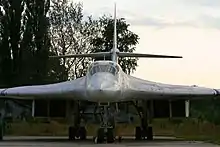
The Tu-160 is a variable-geometry wing aircraft. The aircraft employs a fly-by-wire control system with a blended wing profile, and full-span slats are used on the leading edges, with double-slotted flaps on the trailing edges and cruciform tail.[28] The Tu-160 has a crew of four (pilot, co-pilot, bombardier, and defensive systems operator) in K-36LM ejection seats.[29]
The Tu-160 is powered by four Kuznetsov NK-32 afterburning turbofan engines, the most powerful ever fitted to a combat aircraft. Unlike the American B-1B Lancer, which reduced the original Mach 2+ requirement for the B-1A to achieve a smaller radar cross-section, the Tu-160 retains variable intake ramps, and is capable of reaching Mach 2.05 speed at altitude.[30] The Tu-160 is equipped with a probe-and-drogue in-flight refueling system for extended-range missions, although it is rarely used. The Tu-160's internal fuel capacity of 130 tons gives the aircraft a roughly 15-hour flight endurance at a cruise speed of around 850 km/h (530 mph), Mach 0.77, at 9,100 m (30,000 ft).[31] In February 2008, Tu-160 bombers and Il-78 refueling tankers practiced air refueling during air combat exercise, as well as MiG-31, A-50 and other Russian combat aircraft.[32]
The aircraft carries a TsNPO Leninets Obzor-K (Survey, NATO: Clam Pipe)[33] radar for tracking ground and air targets, and a separate Sopka Terrain-following radar.[34] Although the Tu-160 was designed for reduced detectability to both radar and infrared signature,[35] it is not a stealth aircraft. Nevertheless, Lt. Gen. Igor Khvorov claimed that Tu-160s managed to penetrate the US sector of the Arctic undetected on 25 April 2006, leading to a USAF investigation according to a Russian source.[36]
.jpg.webp)
Weapons are carried in two internal bays, each capable of holding 20,000 kg (44,000 lb) of free-fall weapons or a rotary launcher for nuclear missiles; additional missiles may also be carried externally. The aircraft's total weapons load capacity is 40,000 kg (88,000 lb).[37] No defensive weapons are provided; the Tu-160 is the first post-World War II Soviet bomber to lack such defenses.

A demilitarized, commercial version of the Tu-160, named Tu-160SK, was displayed at Asian Aerospace in Singapore in 1994 with a model of a small space vehicle named Burlak[38] attached underneath the fuselage.
While similar in appearance to the American B-1 Lancer, the Tu-160 is a different class of combat aircraft; its primary role being a standoff missile platform (strategic missile carrier). The Tu-160 is also larger and faster than the B-1B and has a slightly greater combat range, though the B-1B has a larger combined payload.[39] Another significant difference is that the colour scheme on the B-1B Lancer is usually subdued dark gray to reduce visibility; the Tu-160 is painted with anti-flash white, giving it the nickname among Russian airmen "White Swan".[40]
Operational history
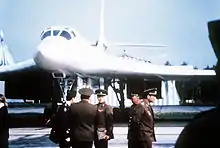
In April 1987, the Tu-160 entered operational service with the 184th Guards Heavy Bomber Regiment located at Pryluky Air Base, Ukrainian SSR.[41] The regiment previously operating Tu-16 and Tu-22M3 strategic bombers became the first unit that received the Tu-160. Squadron deployments to Long Range Aviation began the same month, prior to the Tu-160's first public appearance in a parade in 1989. In 1989 and 1990, a total of 44 world speed flight records in its weight class were set. In January 1992, Boris Yeltsin decided to stop the Tu-160's serial production with 35 aircraft being built at the time. Russia has also unilaterally suspended flights of strategic aviation in remote regions of the world.[42]
A total of 19 Tu-160s were stationed inside the newly independent Ukraine during the dissolution of the Soviet Union. On 25 August 1991, the Ukrainian parliament decreed that the new nation would take control of all military units on its territory; a Defence Ministry was created that same day. By the mid-1990s, the Pryluky regiment had lost its value as a combat unit; 19 Tu-160s were effectively grounded due to a lack of technical support and spare parts. Ukraine considered the Tu-160s to be a bargaining chip in economic negotiations with Russia and of limited value from a military standpoint. Discussions over the Tu-160s were lengthy due to price disagreements. While Russian experts, who examined the aircraft at the Pryluky Air Base in 1993 and 1996, assessed their technical condition as good, the US$3 billion price proposed by Ukraine was considered by Russians as unacceptable. In April 1998, due to the stalled negotiations, Ukraine decided to commence scrapping the aircraft under the Nunn–Lugar Cooperative Threat Reduction agreement. In November, the first Tu-160 was deconstructed at Pryluky.[43]
In April 1999, immediately after NATO's bombing of Yugoslavia, Russia resumed talks with Ukraine about strategic bombers, proposing to purchase eight Tu-160 and three Tu-95MS bombers manufactured in 1991 (those in the best technical condition), as well as 575 Kh-55SM cruise missiles. An agreement was reached and a US$285 million contract was signed, the value of which was deducted from Ukraine's debt for natural gas. On 20 October 1999, a group of Russian military experts went to Ukraine to prepare the aircraft for the flight to Engels-2 air base. The first two aircraft (a Tu-160 and a Tu-95MS) departed Pryluky on 5 November. During the following months, seven other Tu-160s flew to Engels-2, with the last two Tu-95MSs arriving on 21 February 2001.[43]
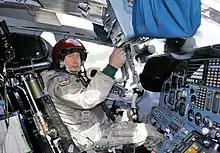
Along with the purchase of Ukrainian aircraft, Russia sought other ways of rebuilding the fleet at Engels-2. In June 1999, the Russian Defence Ministry and Kazan Aircraft Production Association signed a contract for a delivery of a single, almost complete bomber. The aircraft was the second aircraft in the eighth production batch and it arrived at Engels-2 on 10 September. It was commissioned into service on 5 May 2000 and named Aleksandr Molodchiy.[43] The unit operating the fleet from Engels-2 was the 121st Guards Heavy Bomber Regiment which was formed up in early 1992 and received six aircraft by 1994. By the end of February 2001, the fleet stood at 15 with the addition of the eight aircraft from Ukraine and the new-build.[43][44] In 2002, Russian Defence Ministry and KAPO reached an agreement on modernization of the 15 aircraft.[42]
The Russia's Air Force fleet was reduced to 14 due to the crash of the Mikhail Gromov during flight trials of a replacement engine on 18 September 2003.[45][44]
On 22 April 2006, the then commander of the Long-Range Aviation Lieutenant General Igor Khvorov reported a pair of Tu-160 bombers flew undetected through a US-controlled sector during a military exercise in the Arctic.[42][46]
On 5 July 2006, a Tu-160 named Valentin Bliznyuk entered service with the Russian Air Force after completion of its overhaul, bringing the total number back to 15.[7] Built in 1986, it previously served as a test aircraft at Tupolev Design Bureau.[42] It was named after Valentin Bliznyuk, the chief designer of the Tu-160.[7]
On 17 August 2007, Russian President Vladimir Putin announced that Russia was resuming the strategic aviation flights stopped in 1991, sending its bombers on long-range patrols.[47][48] On 14 September 2007, British and Norwegian fighters intercepted two Tu-160s in international airspace near the United Kingdom and Finland, as they were patrolling the North Atlantic.[49][50][42] On 25 December 2007, two Tu-160s came close to Danish airspace and two Danish Air Force F-16s scrambled to intercept and identify them.[51]

On 11 September 2007, according to Russian government sources, a Tu-160 deployed a massive fuel-air explosive device, called Father of All Bombs, for its first field test.[52] Some US military analysts expressed skepticism at the time, that the weapon was actually delivered by a Tu-160.[53]
On 28 December 2007, a new Tu-160 named Vitaly Kopylov performed its first flight.[54] The bomber joined the Russian Air Force on 29 April 2008, increasing the total number of aircraft in service to 16.[42][55][56]
In early 2008, Tu-160s bombers took part in an exercise with the Russian Navy in the Atlantic Ocean.[42] Russia also planned that one new Tu-160 would be delivered every one to two years until the active inventory would reach 30 or more aircraft by 2025–2030.[57][58]

On 10 September 2008, two Tu-160s landed in Venezuela as part of military manoeuvres, announcing an unprecedented deployment to Russia's ally at a time of increasingly tense relations between Russia and the United States. The Russian Defence Ministry said Vasily Senko and Aleksandr Molodchiy were on a training mission. In a statement carried by Russian news agencies, it was reported that the aircraft would conduct training flights over neutral waters before returning to Russia. The aircraft were escorted by NATO fighters as they flew across the Atlantic Ocean.[59]
On 12 October 2008, Tu-160s were involved in the largest Russian strategic bomber exercise since 1984. A total of 12 bombers including Tu-160 and Tu-95 aircraft conducted a series of launches of their cruise missiles. Some bombers launched a full complement of missiles. It was the first time that a Tu-160 had ever fired a full complement of missiles.[60]
On 10 June 2010, two Tu-160s carried out a record-breaking 23-hour patrol with a planned flight range of 18,000 km (9,700 nmi). The bombers flew along the Russian borders and over neutral waters in the Arctic and Pacific Oceans.[61]
In August 2011, Russian media reported that only four of Russia's Air Force sixteen Tu-160s were flight worthy.[15] By mid-2012 Flight International reported eleven were combat-ready[12] and between 2011 and 2013 eleven were photographed in flight.[63]
On 1 November 2013, Aleksandr Golovanov and Aleksandr Novikov entered Colombian airspace on two different occasions without receiving previous clearance from the Colombian government. The aircraft were going from Venezuela to Nicaragua and headed for Managua. The Colombian government issued a letter of protest to the Russian government following the first violation. Two Colombian Air Force IAI Kfirs stationed at Barranquilla intercepted and escorted the two Tu-160s out of Colombian airspace after the second violation.[64][65][66]
On 17 November 2015, as part of the Russian military intervention in the Syrian Civil War, several Tu-160 and Tu-95MS long-range strategic bombers of the Russian Air Force carried out airstrikes at in Idlib and Aleppo provinces using the Kh-101 air-launched cruise missiles fired from the Mediterranean. In total, 34 cruise missiles were fired, destroying 14 important targets. In addition, Tu-22M3 strategic bombers hit numerous claimed IS targets with unguided ammunition. This also marked the combat debut for the Tu-160 and Tu-95MS.[67][68]
In August 2018, a number of Russian military aircraft including two Tu-160, Tu-95MS strategic bombers and Il-78 aerial tankers were deployed for the first time to the Russian Far East as part of a long-range tactical flight exercise. The aircraft completed a 7,000 km non-stop flight from their home base in Saratov Oblast and landed at the Anadyr Airport, Chukotka. During the exercise, the crews practised combat use of cruise missiles at the Komi Test Range and performed flights with aerial refueling.[69][70]
In November 2018, a crew of a modernized Tu-160M test-fired a full complement of 12 Kh-101 cruise missiles at the Pemboi Test Range in the northeastern region of Komi Republic.[71]
On 10 December 2018, two Tu-160s accompanied by an An-124 cargo plane and an Il-62 passenger plane, landed at the Maiquetía airport in Venezuela.[72]
On 14 August 2019, two Tu-160s were again redeployed at the Anadyr Airport, Chukotka in the Russian Far East.
On 23 October 2019, two Tu-160s accompanied by an An-124 cargo plane and an Il-62 passenger plane made a friendly visit to South Africa as part of strengthening ties between the two nations. The aircraft performed a 13 hours non-stop flight over the Caspian Sea, Arabian Sea and Indian Ocean, covering 11,000 km distance with mid-air refueling and landed at Waterkloof Air Force Base in South Africa. It was the Tu-160's first visit to the African continent.[73]
Variants
- Tu-160
- Production version.
- Tu-160S
- Designation used for serial Tu-160s when needed to separate them from all the pre-production and experimental aircraft.[74]
- Tu-160V
- Proposed liquid hydrogen fueled version (see also Tu-155).[74]
- Tu-160 NK-74
- Proposed upgraded (extended range) version with NK-74 engines.[74]
- Tu-160M
- Upgraded version that features new weaponry, improved electronics and avionics, which double its combat effectiveness.
- Tu-160P (Tu-161)
- Proposed very long-range escort fighter/interceptor version.
- Tu-160PP
- Proposed electronic warfare version carrying stand-off jamming and ECM gear (Russian: ПП – постановщик помех "staggering").
- Tu-160R
- Proposed strategic reconnaissance version.
- Tu-160SK
- Proposed commercial version, designed to launch satellites within the "Burlak" (Russian: Бурлак, "hauler") system.[74]
- Tu-160M2
- Highly upgraded version featuring low observable coatings,[75][76][77] new more powerful and efficient engines giving it greater operational range, new avionics, electronics, glass cockpit, communications and control systems, and a number of weapons, as well as improved thrust and unrefueled range. It will also have a new defensive system protecting it from missiles.[78][79] First plane to by ready be late 2021.[80]
Operators
- Russian Aerospace Forces
- Russian Air Force – 17 Tu-160s are in service as of 2018 with one new Tu-160M2 (17th) commissioned in 2018.[81] All aircraft are to be modernized to the "M2" standard.[4][82] Another 10 Tu-160M2 are on order.[23]
- 6950th Guards Air Base – Engels-2 (air base), Saratov Oblast
- 121st Guards Heavy Bomber Aviation Regiment
- 6950th Guards Air Base – Engels-2 (air base), Saratov Oblast
- Russian Air Force – 17 Tu-160s are in service as of 2018 with one new Tu-160M2 (17th) commissioned in 2018.[81] All aircraft are to be modernized to the "M2" standard.[4][82] Another 10 Tu-160M2 are on order.[23]
Former operators
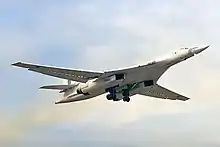
- Soviet Air Forces – aircraft were transferred to Russian and Ukrainian Air Forces after the dissolution of the Soviet Union.
- 201st Heavy Bomber Aviation Division – Pryluky Air Base, Chernihiv Oblast, Ukrainian SSR
- 184th Guards Heavy Bomber Aviation Regiment (GvTBAP)
- 201st Heavy Bomber Aviation Division – Pryluky Air Base, Chernihiv Oblast, Ukrainian SSR
- Ukrainian Air Force – inherited 19 Tu-160s from the former Soviet Union, and subsequently handed over 8 Tu-160s to Russia as exchange for gas debt relief in 1999; the remainder were scrapped under the Nunn–Lugar Cooperative Threat Reduction agreement led by the US.[83][84]
- 201st Heavy Bomber Aviation Division – Pryluky Air Base, Chernihiv Oblast, Ukraine
- 184th Guards Heavy Bomber Aviation Regiment (GvTBAP)
- 201st Heavy Bomber Aviation Division – Pryluky Air Base, Chernihiv Oblast, Ukraine
- 1 Tu-160 in the Poltava Museum of Long-Range and Strategic Aviation[85][86]
Specifications (Tu-160)

Data from Jane's All the World's Aircraft 2003–2004[37]
General characteristics
- Crew: 4 (pilot, co-pilot, bombardier, defensive systems officer)
- Length: 54.1 m (177 ft 6 in)
- Wingspan: 55.7 m (182 ft 9 in) wings spread (20°)
- 35.6 m (117 ft) wings swept (65°)
- Height: 13.1 m (43 ft 0 in)
- Wing area: 400 m2 (4,300 sq ft) wings spread
- 360 m2 (3,875 sq ft) wings swept
- Empty weight: 110,000 kg (242,508 lb)
- Gross weight: 267,600 kg (589,957 lb)
- Max takeoff weight: 275,000 kg (606,271 lb)
- Powerplant: 4 × Samara NK-321 afterburning turbofan engines, 137.3 kN (30,900 lbf) thrust each dry, 245 kN (55,000 lbf) with afterburner
Performance
- Maximum speed: 2,220 km/h (1,380 mph, 1,200 kn) at 12,200 m (40,026 ft)
- Maximum speed: Mach 2.05
- Cruise speed: 960 km/h (600 mph, 520 kn) / M0.9
- Range: 12,300 km (7,600 mi, 6,600 nmi) practical range without in-flight refuelling, Mach 0.77 and carrying 6 × Kh-55SM dropped at mid range and 5% fuel reserves[87]
- Combat range: 2,000 km (1,200 mi, 1,100 nmi) at Mach 1.5
- (7,300 km (4,536 mi)[88])
- Service ceiling: 16,000 m (52,000 ft)
- Rate of climb: 70 m/s (14,000 ft/min)
- Lift-to-drag: 18.5–19, while supersonic it is above 6[89]
- Wing loading: 742 kg/m2 (152 lb/sq ft) with wings fully swept
- Thrust/weight: 0.37
Armament
- Two internal weapon bays for 45,000 kg (99,208 lb) of ordnance.[90]
- Two internal rotary launchers each holding 6× Raduga Kh-55SM/101/102/555 cruise missiles (primary armament) or 12× AS-16 Kickback short-range nuclear missiles.
See also
- PAK DA
- Tupolev Tu-134UBL, used for Tu-160 pilot training
Aircraft of comparable role, configuration, and era
Related lists
References
Notes
- "The upgraded Tu-160 performed its first flight". Russian Aviation. 27 November 2014. Archived from the original on 26 September 2015. Retrieved 20 November 2015.
- "Tupolev Tu-160 (Blackjack) Strategic Long-Range Heavy Supersonic Bomber Aircraft - Soviet Union". www.militaryfactory.com. Archived from the original on 6 October 2018. Retrieved 29 December 2018.
- "Largest military aircraft by weight, operational bomber". Guinness World Records. Archived from the original on 6 October 2018. Retrieved 29 December 2018.
- "Все бомбардировщики Ту-160 модернизируют". Rossiyskaya Gazeta. 28 April 2017. Archived from the original on 18 June 2017. Retrieved 1 May 2017.
- Sergeyev, Pavel (30 April 2008). Белый лебедь [White Swan]. Lenta.ru (in Russian). Archived from the original on 17 July 2011. Retrieved 5 August 2009.
- Goebel, Greg. "The Sukhoi T-4 & Tupolev Tu-160". AirVectors.net. v1.0.4 - 01 mar 15 - greg goebel - public domain. Archived from the original on 18 March 2015. Retrieved 3 March 2015.
- "Tu-160 returns from overhaul". russianforces.org. 5 July 2006. Archived from the original on 3 November 2013. Retrieved 8 December 2019.
- "Russia can hope for new Blackjack bomber in 2006 – Ivanov". RIA Novosti. 5 July 2006. Archived from the original on 6 January 2010. Retrieved 3 August 2009.
- Jennings, Gareth (20 November 2014). "Russia flies first radar- and avionics-upgraded Tu-160 bomber". IHS Jane's Defence Weekly. Archived from the original on 10 March 2015. Retrieved 2 March 2015.
- John Pike. "Tu-160 BLACKJACK (TUPOLEV)". GlobalSecurity.org. Archived from the original on 17 June 2009. Retrieved 11 July 2009.
- Jennings, Gareth (28 July 2013). "Russia continues Tu-160 'Blackjack' bomber modernisation work". IHS Jane's Defence Weekly. Archived from the original on 22 November 2013. Retrieved 21 November 2013.
- Karnozov, Vladimir (15 October 2012). "IN FOCUS: Russian's next-generation bomber takes shape". Flight International. Archived from the original on 5 November 2013. Retrieved 21 November 2013.
- Perry, Dominic (19 December 2014). "Russian air force takes first modernised Tupolev bombers". Flightglobal. Reed Business Information, RELX Group. Archived from the original on 27 September 2015. Retrieved 2 May 2015.
- "The upgraded Tu-160 performed its first flight". Russian Aviation. 27 November 2014. Archived from the original on 18 May 2015. Retrieved 3 May 2015.
- Johnson, Reuben F (11 November 2013). "Further delays for modernisation of Russian Air Force Tu-160 bombers". IHS Jane's Defence Weekly. Archived from the original on 16 November 2013. Retrieved 21 November 2013.
- Kramnik, Ilya (16 September 2011). Бомбардировщики Ту-160 могут остаться без двигателей [Tu-160 bombers may be left without engines]. Izvestia (in Russian). Archived from the original on 26 September 2015. Retrieved 20 November 2015.
- Stevenson, Beth (30 April 2015). "Russia to reestablish Tu-160 supersonic bomber production line". Flightglobal. Archived from the original on 17 December 2015. Retrieved 20 November 2015.
- "Putin made decision to revive production of Tu-160M strategic bomber — Air Force commander". TASS. 28 May 2015. Archived from the original on 23 June 2015. Retrieved 20 November 2015.
- "Путин поздравил авиастроителей с новым стратегическим бомбардировщиком Ту-160М2". Zvezda. 16 November 2017. Archived from the original on 7 February 2018. Retrieved 17 February 2018.
- "Рогозин доложил Путину о постройке новых ракетоносцев Ту-160М2". regnum.ru. 16 November 2017. Archived from the original on 7 February 2018. Retrieved 17 February 2018.
- "Новый Ту-160 начал летные испытания". bmpd. 25 January 2018. Retrieved 27 January 2018.
- "Кадры демонстрационного полета Ту-160М "Петр Дейнекин"". Zvezda. 25 January 2018. Archived from the original on 27 January 2018. Retrieved 27 January 2018.
- "Дальняя авиация получит 10 Ту-160М2 за 160 млрд рублей". Vedomosti. 25 January 2018. Archived from the original on 2 February 2018. Retrieved 6 February 2018.
- "Посещение Казанского авиационного завода имени С.П.Горбунова". kremlin.ru. 28 January 2018. Archived from the original on 19 February 2018. Retrieved 17 February 2018.
- "First Tu-160M2 takes flight, production contract for ten aircraft signed". russianforces.org. 26 January 2018. Archived from the original on 2 February 2018. Retrieved 17 February 2018.
- Путин предложил сделать на базе Ту-160 гражданский авиалайнер Archived 7 February 2018 at the Wayback Machine Zvezda TV, 25 January 2018.
- Гражданский авиалайнер на базе ракетоносца Ту-160. Реально ли? Archived 14 February 2018 at the Wayback Machine BBC, 25 January 2018.
- Bergmans, Werner (1996–2011). "Tupolev Tu-160 Blackjack". Fighter-Planes.com. Werner Bergmans, Eindhoven, the Netherlands. Archived from the original on 2 April 2015. Retrieved 2 March 2015.
- Duffy, Paul; Kandalov, Andrei I. (1996). Tupolev: The Man and His Aircraft (illustrated ed.). Warrendale, PA: SAE International, 1996. p. 170. ISBN 1560918993. Retrieved 2 March 2015.
- "Russian Tu-160 Blackjack strategic bomber". RIA Novosti. 2013. Archived from the original on 2 November 2013. Retrieved 21 November 2013.
- "Aircraft Museum – Tu-160 'Blackjack'." Archived 14 October 2007 at the Wayback Machine Aerospaceweb.org, 16 August 2008. Retrieved 19 July 2009.
- "Tu-160 bombers practice air refueling in Feb 2008 exercises" Archived 2 October 2011 at the Wayback Machine AirForceWorld.com. Retrieved 3 September 2011.
- "Overscan's guide to Russian Military Avionics". Archived from the original on 7 July 2012.
- "Tupolev Tu-160 'Blackjack'". MILAVIA. Archived from the original on 28 February 2015. Retrieved 22 January 2015.
- Lake, Jon (2002). The Great Book of Bombers: The World's Most Important Bombers from World War I to the Present Day. St, Paul. MN: MBI Publishing Company. p. 481. ISBN 978-0760313473.
- "Russian bombers flew undetected across Arctic – AF commander." Archived 11 April 2008 at the Wayback Machine RIA Novosti, 22 April 2006. Retrieved 22 April 2008
- Jackson 2003, pp. 425–426.
- Burlak Archived 28 March 2010 at the Wayback Machine
- The Directory of the World's Weapons 1996, p. 140.
- "'White swan' – Russian supersonic aircraft". Moscow Top News. 2009. Archived from the original on 2 June 2009. Retrieved 19 July 2009.
- Miller, David (1998). The Cold War: A Military History (Pimlico 2001 ed.). London: John Murray, Random House. p. 162. ISBN 1-44813793-4.
- "Померяемся дальней авиацией?". lenta.ru. 25 July 2008. Retrieved 8 December 2019.
- Butowski, Piotr. "Russia's Strategic Bomber Force". Combat Aircraft. 4 (6): 552–565.
- "Ту-160 принят на вооружение". take-off.ru. December 2005. Archived from the original on 15 March 2008. Retrieved 8 December 2019.
- "Russian supersonic bomber crashes". Ananova. Associated Press. 18 September 2003. Archived from the original on 20 September 2003.
- "Russians claim bomber flights over US territory went undetected". Flight Global. 24 April 2006. Retrieved 9 December 2019.
- "Russia orders long-range bomber patrols". USA Today. 17 August 2007. Archived from the original on 6 November 2018. Retrieved 12 January 2020.
- "Russia Resumes Patrols by Nuclear Bombers". The New York Times. 17 August 2007. Archived from the original on 29 August 2019. Retrieved 12 January 2020.
- Satter, Raphael G. "NATO jets intercept Russian warplanes." Archived 5 December 2008 at the Wayback Machine USA Today, 14 September 2007. Retrieved 19 July 2009.
- Bugajski, Janusz (2008). Expanding Eurasia: Russia's European Ambitions (illustrated ed.). Washington, D.C.: CSIS Press. p. 143. ISBN 978-0892065455.
- "Danish fighter jets v. Russian bombers: 18-minute chase." russiatoday.ru, 26 December 2007. Retrieved 19 July 2009.
- "Russia tests giant fuel-air bomb." Archived 29 March 2017 at the Wayback Machine BBC News, 12 September 2007. Retrieved 3 August 2009.
- Axe, David and Daria Solovieva. "Did Russia Stage the Father of All Bombs Hoax?" Archived 15 April 2017 at the Wayback Machine Wired, 4 October 2007. Retrieved 15 November 2014.
- "New serial Tu-160 Blackjack bomber undergoes flight test". RIA Novosti. 12 December 2008. Archived from the original on 15 October 2008. Retrieved 3 August 2009.
- "Модернизированный Ту-160 передали в состав ВВС России". oreanda.ru. 29 April 2008. Retrieved 8 December 2019.
- "ВВС России получили новый самолет". ntv.ru. 29 April 2008. Retrieved 9 December 2019.
- "Russian Air Force receives new Tu-160 strategic bomber'" Archived 1 May 2008 at the Wayback Machine RIA Novosti, 10 January 2008. Retrieved 3 August 2009.
- "На КАПО им.Горбунова испытали новый серийный Ту-160" (in Russian). Archived 24 January 2008 at the Wayback Machine Tatar-Inform Information Agency, Kazan, 6 January 2008. Retrieved 5 August 2009
- "Russian bombers land in Venezuela." Archived 27 March 2010 at the Wayback Machine BBC News, 11 September 2008. Retrieved 3 August 2009.
- "Russia plans biggest missile test for 24 years." Archived 3 March 2016 at the Wayback Machine The Daily Telegraph, 7 October 2008. Retrieved 3 August 2009.
- "Russian strategic bombers complete record duration flight." Archived 14 June 2010 at the Wayback Machine The Moscow News via mn.ru, 10 June 2010. Retrieved 30 June 2010.
- "Russian bombers fly around Europe to strike Syria in 8,000 mile show of strength". The Daily Telegraph. 20 November 2015. Archived from the original on 21 April 2019. Retrieved 18 April 2020.
- Axe, David (13 November 2013). "We Just Hunted Down All of Russia's Long-Range Bombers". War is Boring. Archived from the original on 13 November 2013. Retrieved 14 November 2013.
- "Colombia enviará nota de protesta a Rusia por violación del espacio aéreo" [Colombia will send a note of protest to Russia for violation of airspace]. El Espectador (in Spanish). 5 November 2013. Archived from the original on 24 September 2015. Retrieved 20 November 2015.
- "Colombia says Russian bombers violated its airspace". Reuters. 5 November 2013. Archived from the original on 21 November 2015. Retrieved 20 November 2015.
- "Colombia Protests Violation of Airspace by Russian Bombers". The Moscow Times. 7 November 2013. Archived from the original on 21 November 2015. Retrieved 20 November 2015.
- Cenciotti, David (17 November 2015). "25 Russian long-range strategic bombers in action over Syria for the very first time". The Aviationist. Archived from the original on 20 November 2015. Retrieved 20 November 2015.
- Oliphant, Roland; Akkoc, Raziye; Steafel, Eleanor (17 November 2015). "Paris attacks: Cameron to make case for Syria military action as EU troops could be sent to France - latest news". The Daily Telegraph. Online. Archived from the original on 17 November 2015. Retrieved 17 November 2015.
- "Экипажи Ту-160 впервые в истории выполнили посадку на аэродром Анадырь в ходе учения дальней авиации". function.mil.ru. 16 August 2018. Archived from the original on 18 December 2018. Retrieved 17 December 2018.
- "Russian Supersonic Bombers Deploy Near Alaska 'For First Time in History'". themoscowtimes.com. 17 August 2018. Archived from the original on 29 December 2018. Retrieved 17 December 2018.
- "Russian strategic Tu-160 bomber test-fires 12 missiles". TASS. 18 December 2018. Archived from the original on 20 December 2018. Retrieved 20 December 2018.
- Vladimir Isachenkov (10 December 2018). "Russia Just Sent Two Nuclear-Capable Bombers to Venezuela". Time. Archived from the original on 11 December 2018. Retrieved 11 December 2018.
The bombers’ deployment follows Venezuelan President Nicolas Maduro’s visit to Moscow last week in a bid to shore up political and economic assistance even as his country has been struggling to pay billions of dollars owed to Russia.
- "На аэродроме в ЮАР приземлились два российских ракетоносца Ту-160". Ria. 23 October 2019. Retrieved 25 October 2019.
- Aviation and Cosmonautics magazine, 5.2006, pp. 10–11. OCLC 24440468.
- "Russia Rolls Out New Tu-160M2, But Are Moscow's Bomber Ambitions Realistic? - The Drive". Archived from the original on 7 February 2019.
- Franz-Stefan Gady, The Diplomat. "Russia to Receive Entire Fleet of Upgraded Supersonic Nuclear-Capable Bombers by 2030". The Diplomat. Archived from the original on 6 December 2018. Retrieved 29 December 2018.
- Majumdar, Dave (23 March 2018). "Here's Why Russia's 'New' Tu-160M2 Could Be NATO's Worst Nightmare". The National Interest. Archived from the original on 6 December 2018. Retrieved 29 December 2018.
- "Russia to Launch Serial Production of Upgraded Tu-160M2 Strategic Bomber". DefenceTalk.com. 14 April 2017. Archived from the original on 26 October 2017. Retrieved 29 October 2017.
- "Russia Says Its Future Bombers Will Have Protection From "All Missiles" - The Drive". Archived from the original on 7 February 2019.
- https://tass.com/defense/1241341
- Long-range aviation received four upgraded Tu-95MS aircraft and one Tu-160 aircraft. (rus). tvzvezda.ru, 23.12.2018
- "Новый Ту-160 назвали в честь командовавшего уничтожением авиации Ичкерии". Lenta.ru. 24 January 2018. Archived from the original on 25 January 2018. Retrieved 27 January 2018.
- "Ukraine Bomber Decommissioning and Transfer Chronology" (PDF). Nuclear Threat Initiative. April 2005. Archived (PDF) from the original on 13 August 2018. Retrieved 3 March 2015.
- "How Americans destroyed Ukraines best Military devices, the Tu 160 Bomber". Youtube. 24 April 2014. Archived from the original on 9 March 2016. Retrieved 20 November 2015.
- "Long Range Aviation Museum". Tourism.Poltava.ua. Cooperative project of Fox Web Workshop and city executive committee Dept. of Culture and Tourism. Archived from the original on 2 April 2015. Retrieved 3 March 2015.
- Музей дальней авиации, Полтава [Museum of long-range aviation, Poltava] (in Russian). Archived from the original on 18 August 2012. Retrieved 17 November 2012.
- Taylor 1996, p. 103.
- "Tu-160 BLACKJACK (TUPOLEV)". GlobalSecurity.org. Archived from the original on 17 June 2009. Retrieved 16 August 2019.
- ХАРАКТЕРИСТИКИ БОМБАРДИРОВЩИКА Ту-160 [Tu-160 bomber specifications] (in Russian). airforce.ru. Archived from the original on 25 April 2009. Retrieved 3 August 2009.
- "В Минобороны доказали превосходство Ту-160 над американским B-1B". ria.ru. 23 December 2018. Archived from the original on 25 December 2018. Retrieved 25 December 2018.
Bibliography
- The Directory of the World's Weapons. Leicester, UK: Blitz Editions, 1996. ISBN 978-1-85605-348-8.
- Eden, Paul (ed.). The Encyclopedia of Modern Military Aircraft. London: Amber Books, 2004. ISBN 1-904687-84-9.
- Jackson, Paul. Jane's All The World's Aircraft 2003–2004. Coulsdon, UK: Jane's Information Group, 2003. ISBN 0-7106-2537-5.
- Taylor, Michael J. H. Brassey's World Aircraft & Systems Directory. London: Brassey's, 1996. ISBN 1-85753-198-1.
External links
| Wikimedia Commons has media related to Tupolev Tu-160. |
- Tu-160 page at GlobalSecurity.org
- "Первый полет нового стратегического ракетоносца Ту-160" [First flight of new strategic missile carrier Tu-160]. United Aircraft Corporation (in Russian). 25 January 2018. Retrieved 25 January 2018 – via YouTube.
